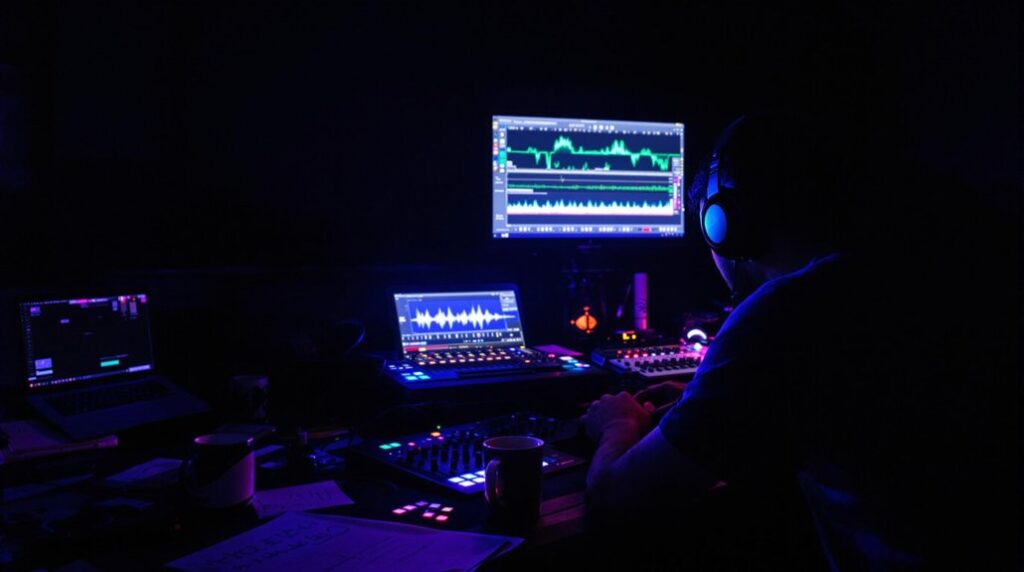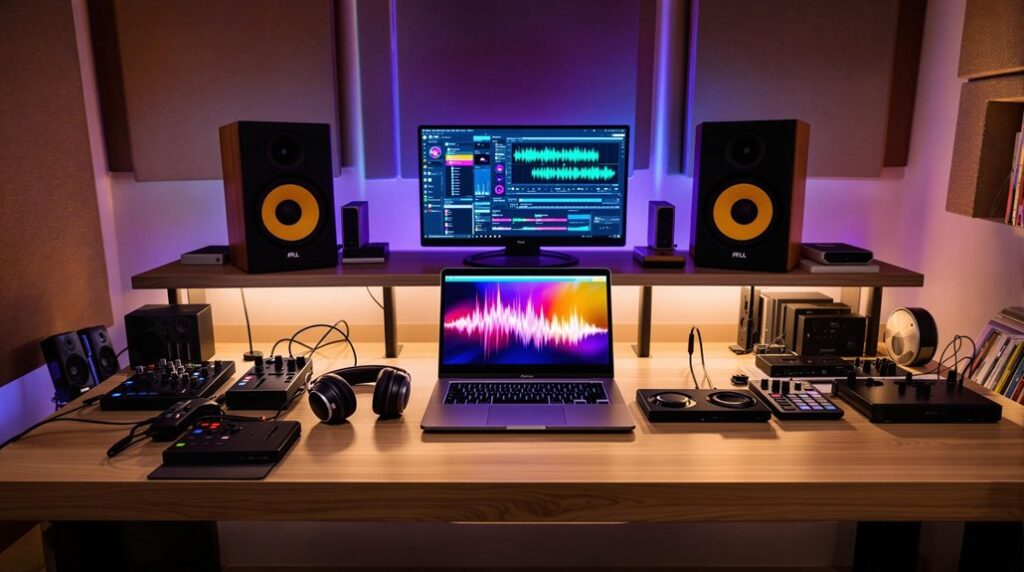To fix muddy mixes, focus on managing your low-mid frequencies (200-500 Hz). Use spectral analyzers to identify problem areas and apply notch EQ to surgically remove unwanted frequencies. Implement high-pass filters below 100-120 Hz to clear the low end. Balance your kick and bass with sidechain compression to prevent overlap and muddiness. Distribute instruments using panning to avoid overcrowding the mix. Regularly compare your mix to professional reference tracks to guarantee clarity. Maintain proper headroom around -18 dBFS and monitor levels to avoid distortion. With these techniques, you’ll achieve a clearer, more professional sound. Explore further for detailed insights.
Key Takeaways
- Use notch EQ to surgically remove problematic low-mid frequencies (200-500 Hz).
- Apply high-pass filters to eliminate excessive low-end frequencies below 100-120 Hz.
- Utilize spectral analyzers to identify and address muddiness in the mix.
- Employ sidechain compression to create space between kick and bass.
- Regularly reference professional tracks to compare and adjust frequency balance.
Understanding Muddy Mixes
When you’re trying to create a polished track, understanding what causes muddy mixes is essential to achieving a clear and dynamic sound.
Muddy mixes often stem from an over-saturation of the low mid-frequency range (200-500 Hz). This frequency buildup can lead to a dull, clouded sound, robbing your mix of sound clarity and balanced audio dynamics. To combat this, effective frequency management and mixing strategies are pivotal.
Poor recording quality, overcrowded mixes, imbalanced tracks, and excessive effects are common culprits behind muddiness. During both recording and mixing stages, ensuring each element occupies its appropriate frequency space is critical. Utilize tools like spectral analyzers to visualize frequency distributions and identify problematic areas.
Implement corrective EQ to attenuate excess low mids and enhance clarity. Balancing tracks by adjusting volume levels and panning positions can also prevent frequency clashes. Rearrange elements to ensure each sound has its distinct place within the mix, promoting a cleaner and more dynamic output.
Identifying Problem Frequencies
Pinpointing problem frequencies involves using spectral analyzers to visually identify and address muddiness in your mix. These tools provide a detailed view of your frequency spectrum, making it easier to spot excessive energy in the low-mid range, typically between 200-500 Hz. This range is notorious for causing frequency masking, where important elements of your mix get overshadowed, reducing overall audio clarity.
To tackle this, you should employ precise mixing techniques. Utilize notch and bell EQ curves to surgically remove problem frequencies. Start by sweeping through the low-mid range with a narrow EQ boost to audibly identify the most problematic areas. Once located, switch to a cut and reduce the identified frequencies. This method ensures you retain the integrity of your mix while improving clarity.
Problem frequency removal is essential for a balanced mix. By addressing these muddy areas, you allow each element to breathe and stand out, enhancing the overall sound quality.
Regularly referencing your spectral analyzer during the mixing process helps maintain a clear, professional mix, free from unwanted muddiness. This precise approach guarantees your mixes achieve optimum audio clarity.
Effective Sound Selection
After identifying and addressing problem frequencies, the next step is to focus on effective sound selection to make sure each element in your mix complements the others. Start by choosing high-quality samples that naturally blend well. This can significantly improve your mix clarity and overall sound quality.
To achieve this:
- Sample Selection: Invest time in selecting the right samples. High-quality sounds are vital for a clean mix.
- Sound Comparison: Use your DAW’s tools to compare different sounds. Hot swapping samples and presets can help you find the perfect fit.
- Mix Clarity: Pay special attention to how each sound interacts with others. Avoid overlapping frequencies to maintain clarity.
- Sound Quality: Choose sounds that inherently have a good tonal balance. This reduces the need for excessive EQ and processing later.
Managing Kick and Bass
Balancing the kick and bass frequencies is crucial to prevent muddiness and guarantee a clear, powerful low-end in your mix. Start by carefully managing kick dynamics to make sure your kick drum cuts through without overpowering the bass. Use bass compression to maintain a consistent volume and prevent the bass from becoming too boomy or inconsistent. This helps in achieving a precise low end balance.
One effective technique is to employ sidechain compression. By sidechaining the bass to the kick, you allow the bass to momentarily duck when the kick hits. This creates space for the kick and enhances the clarity of both elements. Adjust the attack and release settings to fine-tune the interaction between the kick and bass, ensuring a seamless blend without noticeable pumping.
Pay close attention to the relationship between the kick and bass levels. Regularly monitor and adjust them to maintain a solid foundation without causing muddiness. Experiment with different dynamics and compression settings to find the perfect balance.
Using EQ Techniques
Start by using notch EQ to target and reduce specific problem frequencies in the low-mids, typically between 200-500 Hz, to address muddiness.
Apply a high-pass filter to remove excessive low-end frequencies below 100-120 Hz, enhancing overall clarity.
Carve out space by focusing EQ cuts on secondary elements, allowing core components like kick and bass to stand out.
Identify Problem Frequencies
To identify problem frequencies in your mix, utilize a spectral analyzer to scrutinize the 200-500 Hz range meticulously. This frequency band often harbors muddiness that can cloud your mix. Employing corrective EQ techniques is essential to surgically cut out those muddiness-inducing frequencies.
Here’s how to approach it:
- Frequency Notching: Use a narrow EQ band to notch out specific problem frequencies. Start by sweeping through the 200-500 Hz range to locate the offending frequencies that make your mix sound muddy.
- EQ Precision: Once you’ve pinpointed the problem frequencies, employ precision in your EQ adjustments. Make surgical cuts to remove only the necessary frequencies without affecting the overall balance.
- Bell EQ Curves: Utilize bell EQ curves for targeted cuts. This method helps in enhancing mix clarity by removing just enough of the problematic frequencies while preserving the musicality of the mix.
- Fine-Tune Filter Width: Adjust the width of your EQ filters carefully. A narrower filter (high Q-factor) can effectively remove the problem frequencies without sacrificing too much of the surrounding audio content.
Apply High-Pass Filter
After identifying and addressing problem frequencies, the next step is to apply a high-pass filter to each instrument channel to clean up the low end effectively. This EQ technique targets frequencies below a certain cutoff point, allowing you to remove unnecessary low-end information that can muddy your mix.
Start by setting the high-pass filter on each track, adjusting the cutoff frequency based on the specific instrument and its role in the mix. For instance, bass-heavy instruments like kick drums and bass guitars might need a lower cutoff point, around 30-60 Hz, to retain their power while removing inaudible rumble.
In contrast, higher-pitched instruments like guitars or vocals can have higher cutoff points, around 80-120 Hz, to eliminate low-end clutter without sacrificing their fullness.
It’s essential to make frequency adjustments with precision, considering the genre of music and your personal preference for sound enhancement. Applying high-pass filters is one of the most effective filter techniques and mixing tips for reducing muddiness in your mix.
Carve Out Space
In the pursuit of a clear and balanced mix, carving out space using EQ techniques is essential for preventing frequency clashes and ensuring each instrument stands out.
Here’s how to do it effectively:
- Frequency Notching: Target problem frequencies in the low-mids (around 200-500 Hz) using notch EQ. This helps eliminate unwanted resonances and boosts mix clarity. Carefully identify and reduce these problem areas to make certain each instrument retains its unique presence without muddying the mix.
- High-Pass Filters: Apply high-pass filters to remove excessive low-end frequencies. This technique is vital for space creation, allowing you to carve out room for the essential elements, such as the bass and kick drum, without cluttering the mix.
- Low-End Roll-Off: Implement low-end roll-off techniques around 100-120 Hz. This reduces muddiness while preserving the natural sound of the instruments. By focusing on the sub-frequency range, you can maintain a clean, tight low-end.
- Auxiliary Channel Management: Use auxiliary channels for spatial effects like reverb and delay. Roll off low-end frequencies on these channels to enhance mix clarity and avoid adding unnecessary low-end content, which can muddy the overall sound.
Filtering Unnecessary Frequencies
When aiming to clear up your sound, applying high pass filters to each instrument channel effectively removes excessive low-end frequencies that muddy the mix. By engaging in frequency isolation, you can guarantee each instrument occupies its intended space without overlapping unnecessarily with others in the low-frequency range. Set your high pass filters to cut below 100-120Hz for most instruments, sparing the kick and bass, which anchor the low end.
In audio sculpting, utilizing notch EQ can further refine your mix by targeting specific frequencies causing muddiness in the low-mids. Implementing tools like FabFilter Pro-Q 3 allows for visual identification and removal of these problematic areas. This clearing clutter technique is essential for sonic refinement, helping each element in your mix shine through clearly.
High pass filtering aids in finding the right balance between fullness and clarity, preventing overlapping frequencies from masking important sonic details. For more precise adjustments, EQ tools like BASSROOM can be employed to cut problematic low-mids, further enhancing clarity.
Balancing Your Mix
Having established a cleaner frequency spectrum, the next step is to balance your mix by guaranteeing each instrument occupies its own space within the stereo field and frequency range. Proper balance prevents frequency masking and enhances stereo imaging, which adds depth and clarity to your mix.
Here’s how to achieve a well-balanced mix:
- Use panning: Spread instruments across the stereo field. For instance, panning guitars slightly left and right can create space for vocals in the center.
- Adjust volume levels: Make sure no single instrument overpowers the mix. Use faders to set appropriate levels, maintaining a cohesive sound.
- Utilize EQ: Carve out specific frequencies for each instrument. Cut frequencies that clash and boost those that enhance the instrument’s presence, reducing muddiness.
- Reference professional tracks: Regularly compare your mix to professionally mixed tracks. This helps you gauge balance and overall sound quality.
Utilizing Auxiliary Channels
Auxiliary channels offer a powerful method for integrating spatial effects like reverb and delay into your mix while maintaining the clarity of the dry signal. By employing effective mixing techniques and routing strategies, you can enhance spatial effects without muddying the mix.
One essential approach is to route your instruments to auxiliary channels dedicated to these effects. This separation allows you to apply reverb or delay selectively, guaranteeing that the original signal remains clear and defined.
A critical step in clarity enhancement is rolling off low-end frequencies on your auxiliary channels. Cutting frequencies below 120Hz prevents low-end buildup, which can obscure the mix’s overall clarity. This technique ensures that the spatial effects add depth and dimension without compromising the mix’s low-end balance.
Utilizing auxiliary channels also facilitates better control over spatial effects. By adjusting the send levels, you can fine-tune the amount of reverb or delay applied to each instrument. This flexibility helps maintain a cleaner mix, as the dry and wet signals are managed independently.
Ultimately, these routing strategies boost separation and definition, leading to a more polished and professional sound.
Employing Reference Tracks
Start by choosing reference tracks that exemplify the clarity and balance you aim to achieve.
By analyzing their frequency distribution and dynamics, you can pinpoint specific elements contributing to a clean mix.
Use these insights to guide your EQ adjustments and overall sound quality, ensuring a professional, clear mix through A/B referencing.
Choosing Reference Tracks
To effectively employ reference tracks, you should select ones that exemplify the clarity and balance you’re aiming to achieve in your mix. Choosing the right reference tracks is vital for critical analysis and comparative frequency analysis, which are essential for mix improvement.
Here are four steps to guide your reference track selection:
- Genre Matching: Choose reference tracks within the same genre as your project. This guarantees that the tonal balance and instrumentation are relevant and provide a meaningful benchmark.
- Professional Quality: Select tracks that are professionally mixed and mastered. These tracks should exemplify the industry standards for clarity, balance, and overall production quality.
- Frequency Response: Evaluate tracks based on their frequency distribution. Use analytical tools to compare frequency spectrums and identify where your mix diverges, helping you target specific areas for improvement.
- Personal Preference: Choose tracks that you admire and aspire to sound like. Your familiarity with these tracks will aid in critical analysis and provide a clear goal for your mixing process.
Using these steps, you’ll be better equipped to identify muddiness and guide your EQ adjustments. Reference tracks are your roadmap to achieving a polished, professional sound, helping you set a tonal balance and analyze dynamics effectively.
Analyzing Track Elements
Leveraging reference tracks effectively, you can analyze key elements like kick, bass, and vocals to identify frequency imbalances and improve your mix clarity. Begin by selecting high-quality reference tracks that embody the clarity, balance, and overall mix quality you aim to achieve.
Use spectral analyzers for frequency visualization to compare your mix with the reference tracks. This comparison highlights where your frequencies might be clashing or lacking.
Focus on the kick, bass, and vocals, as these elements often define the foundational balance of your mix. For instance, if your bass and kick are muddy, observe how the reference tracks handle their low-end frequencies. Notice the frequency ranges and levels at which these elements sit in the reference mix.
Apply this insight to make precise EQ adjustments, ensuring each element has its own space. Use panning decisions to separate competing frequencies further, enhancing overall mix clarity.
Continuously refer back to your reference tracks during this process. They serve as benchmarks, guiding you toward a more polished and balanced mix. By methodically employing these techniques, you’ll achieve a cleaner, more professional sound.
Maintaining Proper Headroom
Maintaining adequate headroom in your mix is crucial for preserving clarity and preventing distortion. Proper headroom management is a fundamental aspect of mixing techniques, directly impacting sound clarity. In audio production, keeping headroom around -18 dBFS average level with peaks around 9-10 dBFS is recommended. This practice not only aids in achieving a clean mix but also makes mastering levels more manageable.
To uphold proper headroom, follow these steps:
- Gain Staging: Start by setting appropriate levels for each track. Ensure that no individual track’s volume is too high, which can lead to clipping and reduce overall headroom.
- Monitor Levels: Regularly check the master bus levels. Avoid hot levels; they can distort the mix and compromise dynamic range, resulting in a muddy sound.
- Use Meters: Utilize VU meters and peak meters to monitor levels accurately. Ensure your average levels hover around -18 dBFS and peaks around 9-10 dBFS.
- Dynamic Control: Use compression and limiting judiciously. These tools can assist in managing peaks, preserving headroom while maintaining the desired dynamic range.
Frequently Asked Questions
How to Make Your Mix Sound Less Muddy?
To make your mix sound less muddy, use high pass filters, apply notch EQ on low-mids, and roll off reverb’s low-end. Enhance stereo imaging and add harmonic saturation for depth and clarity. Switch to mono for phase issues.
How Do You Get Rid of Muddy Frequencies?
To get rid of muddy frequencies, optimize speaker placement and room acoustics first. Use EQ to cut low-mid frequencies around 200-500 Hz, apply high-pass filters, and utilize dynamic EQ. Balance the mix with shelving EQ and maintain gain consistency.
How Do You Clean Muddy Audio?
To clean muddy audio, use noise reduction tools to eliminate unwanted background sounds first. Then, apply dynamic processing to control frequencies causing muddiness, ensuring precise adjustments. This approach enhances clarity and balance in your mix.
How Do You Fix Muddy Eq?
To fix muddy EQ, use EQ techniques like notch EQ to target specific low-mid frequencies causing issues. Apply high-pass filters to instruments. Utilize visual EQ tools to identify and address frequency masking, ensuring clarity and precision in your mix.
How Do You Fix a Muddy Bass Tone?
To fix a muddy bass tone, start with bass layering by adding a dedicated sub bass track. Use tone shaping with notch EQ to target muddiness in the 200-500Hz range, ensuring a clean, powerful bass presence.
Conclusion
By understanding muddy mixes, identifying problem frequencies, and selecting effective sounds, you can achieve clarity in your sound.
Manage kick and bass interactions, use EQ techniques wisely, and balance your mix for precision.
Utilize auxiliary channels and reference tracks to maintain consistency.
Don’t forget to maintain proper headroom for a polished, professional finish.
Follow these steps, and you’ll transform your mixes from cluttered to clear, ensuring every element shines through distinctly.




